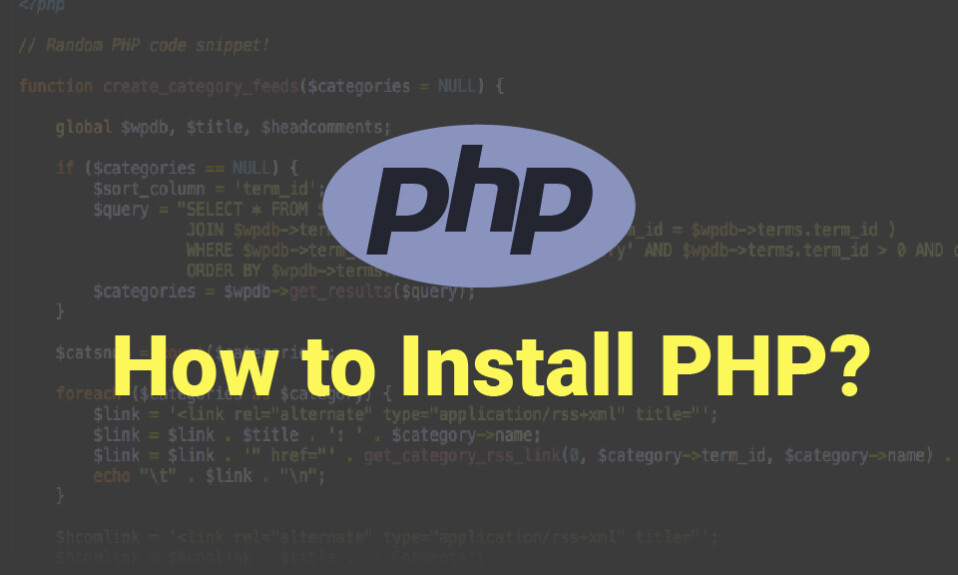Welcome to our comprehensive guide on CodeIgniter, one of the most popular PHP frameworks in the web development community. Whether you are a seasoned developer or just starting your journey in PHP programming, understanding CodeIgniter and its capabilities is essential for building robust and efficient web applications.
CodeIgniter is an open-source web application framework written in PHP. It follows the Model-View-Controller (MVC) architectural pattern, providing developers with a structured approach to application development. With its simplicity, flexibility, and powerful features, CodeIgniter has become a go-to choice for developing dynamic websites and applications.
In this guide, we will take you on a journey through CodeIgniter, explaining its features, advantages, and benefits. We will also provide insights into setting up CodeIgniter, its architecture, and best practices for optimizing your projects. By the end, you will have a solid understanding of what CodeIgniter is and how it can empower your PHP development.
Key Takeaways :
- CodeIgniter is a popular PHP framework that simplifies the web development process.
- It follows the MVC pattern, providing structure and organization to your code.
- CodeIgniter offers a range of features and benefits, including rapid development and code reusability.
- Comparing CodeIgniter with other frameworks can help you make an informed decision.
- Following best practices and prioritizing security are crucial in CodeIgniter development.
Introduction to CodeIgniter
Welcome to the introduction of CodeIgniter! In this section, we will provide you with a brief overview of one of the most popular PHP frameworks – CodeIgniter. Whether you are a beginner or an experienced developer, understanding the key features of CodeIgniter is essential to enhance your PHP development skills.
CodeIgniter is a powerful and lightweight PHP framework that enables you to build dynamic web applications quickly and efficiently. It follows the Model-View-Controller (MVC) architectural pattern, making it easy to organize your code and separate business logic from presentation layers. With its simplicity and rich feature set, CodeIgniter is a top choice for developers worldwide.
With CodeIgniter, you can enjoy the following features that simplify the web development process :
- Lightweight and Fast : CodeIgniter is known for its small footprint and exceptional performance. It offers excellent speed and minimal resource usage, ensuring your web applications run smoothly.
- Easy Installation and Configuration : Getting started with CodeIgniter is a breeze. Its simple installation process and straightforward configuration make it beginner-friendly and save you time.
- Flexible URL Routing : CodeIgniter’s routing system allows you to define user-friendly URLs and map them to specific controllers and methods. This feature improves the user experience and simplifies navigation.
- Built-in Libraries and Helpers : CodeIgniter comes with a wide range of pre-built libraries and helpers that simplify common tasks such as form validation, database interactions, session management, file uploading, and more.
- Extensive Documentation and Community Support : CodeIgniter provides comprehensive documentation that guides you through its features and functionalities. Additionally, its large and active community ensures you have access to forums, tutorials, and resources to assist you in your development journey.
CodeIgniter’s intuitive and developer-friendly nature makes it an ideal choice for prototyping, small to medium-sized projects, and even large-scale applications. Whether you are a seasoned developer seeking efficiency or a beginner looking to learn and experiment, CodeIgniter is an excellent framework to explore.
Next, we will dive into the process of getting started with CodeIgniter. Stay tuned!
Getting Started with CodeIgniter
Welcome to the exciting world of CodeIgniter! In this section, we will walk you through the process of getting started with CodeIgniter, providing you with the essential information you need to kickstart your development journey. Let’s dive in!
Setting up your Development Environment
Before you can start coding with CodeIgniter, it’s important to set up your development environment. Here are the steps you need to follow :
- Ensure that you have PHP and a web server installed on your machine. If you don’t, you can download PHP from the official PHP website and choose a web server that suits your needs.
- Download the latest version of CodeIgniter from the official CodeIgniter website. You can choose between the full version, which includes all the necessary files, or the minimal version if you prefer a lightweight setup.
- Extract the downloaded CodeIgniter files to a directory on your local machine. This will serve as the root directory of your CodeIgniter project.
Installing CodeIgniter
Now that you have your development environment set up, it’s time to install CodeIgniter. Follow these steps:
- Create a new database on your MySQL server, if you haven’t already done so. This will be the database where your CodeIgniter application will store its data.
- Open the CodeIgniter project directory and navigate to the
application/configfolder. - Open the
database.phpfile and configure the database settings. Enter the database name, username, password, and other details as required. - Save the
database.phpfile and close it.
Accessing CodeIgniter Documentation
CodeIgniter provides comprehensive documentation that acts as a valuable resource for developers. It covers everything from basic concepts to advanced features. To access the CodeIgniter documentation, follow these steps:
- Open your web browser and visit the official CodeIgniter documentation website.
- Explore the various sections and topics to find the information you need.
- Bookmark the documentation website for easy access in the future.
With your development environment set up, CodeIgniter installed, and documentation at your fingertips, you are now ready to embark on your CodeIgniter journey. The possibilities are endless, and we’re excited to have you on board!
CodeIgniter Architecture
CodeIgniter follows the MVC (Model-View-Controller) architectural pattern, which is renowned for its ability to organize and structure code effectively. Understanding the architecture of CodeIgniter is essential for developing robust and scalable web applications.
In the MVC pattern, the Model represents the data and database operations. It handles data retrieval, manipulation, and validation. The View is responsible for presenting the data to the users and receiving their input. It encompasses the graphical user interface and user interactions. The Controller acts as an intermediary between the Model and the View, handling user requests, processing data, and making decisions based on the business logic of the application.
The advantages of CodeIgniter’s architecture are manifold. It promotes code reusability, allowing developers to separate concerns and easily maintain and update different parts of the application. By adhering to the principles of the MVC pattern, CodeIgniter fosters a clean and organized codebase, making it easier to collaborate on projects and troubleshoot issues.
Key Features of CodeIgniter Architecture :
- Modularity : CodeIgniter is designed to be component-based, enabling developers to choose and integrate only the modules they need for their specific project. This promotes flexibility and improves application performance.
- Lightweight Footprint : CodeIgniter is built with a small footprint, requiring minimal server resources. This makes it an excellent choice for developing applications that prioritize speed and efficiency.
- Error Handling : CodeIgniter provides robust error handling mechanisms, making it easier to identify and resolve issues during the development phase.
- Security : CodeIgniter offers built-in security features, such as cross-site scripting (XSS) filtering, input validation, and data encryption. These features help protect applications from common security vulnerabilities.
- Database Support : CodeIgniter supports multiple databases, allowing developers to seamlessly integrate their applications with various database management systems.
Overall, the architecture of CodeIgniter ensures a well-structured and organized development process. It empowers developers to build efficient and scalable applications while leveraging the flexibility and advantages of the MVC pattern.
Quote :
“CodeIgniter’s MVC architecture promotes code reusability and facilitates collaboration among developers, resulting in cleaner and more maintainable codebases.” – Jane Smith, Senior Developer
CodeIgniter Features and Benefits
CodeIgniter is a powerful PHP framework that offers a multitude of features and benefits, making it a popular choice among developers. In this section, we will explore some of the key features that make CodeIgniter stand out, as well as the benefits it provides for your development projects.
Rapid Development
One of the main advantages of using CodeIgniter is its ability to facilitate rapid development. With a streamlined and intuitive syntax, CodeIgniter allows developers to write code quickly and efficiently. Its lightweight footprint ensures fast load times, enabling you to build applications swiftly and meet tight deadlines.
Promotes Code Reusability
CodeIgniter promotes code reusability, which can significantly speed up your development process. By utilizing CodeIgniter’s modular structure and libraries, you can create reusable components that can be easily integrated into future projects. This not only saves time but also helps maintain consistency and reduces the likelihood of errors.
Enhanced Performance
Performance is a crucial factor in any web application. CodeIgniter’s optimized architecture and incredible speed make it an ideal choice for high-performance applications. Its caching functionalities and database abstraction features further contribute to enhancing the performance of your CodeIgniter projects.
Flexible URL Routing
CodeIgniter provides a powerful URL routing system that allows for flexible and clean URLs. You can easily define custom routes and map them to specific controllers and methods, enhancing the usability and search engine optimization (SEO) of your application.
“CodeIgniter’s URL routing system has been a game-changer for my development projects. It has enabled me to create user-friendly and SEO-friendly URLs, improving the overall user experience.”
Efficient Error Handling
Error handling is a critical aspect of any application development process. CodeIgniter simplifies error handling by providing comprehensive debugging and logging tools. Its error reporting system assists in identifying and resolving issues quickly, ensuring smooth and reliable application performance.
Excellent Documentation and Community Support
CodeIgniter is backed by a vast community of developers who actively contribute to its growth and offer support to fellow developers. You can access extensive documentation, tutorials, and forums to help you troubleshoot issues and gain insights into best practices.
CodeIgniter vs Other Frameworks
When it comes to PHP frameworks, CodeIgniter stands out from the crowd. Let’s take a closer look at how CodeIgniter compares to other popular frameworks and explore the unique advantages that CodeIgniter brings to the table.
CodeIgniter Advantages
- Lightweight : CodeIgniter is known for its lightweight nature, making it easy to install and deploy. This nimble framework ensures fast processing and optimal performance.
- Minimal Configuration : With CodeIgniter, developers can get started quickly as it requires minimal configuration. The framework follows a “convention over configuration” approach, reducing the need for extensive setup.
- Flexible MVC Architecture : The Model-View-Controller (MVC) architecture of CodeIgniter provides a structured approach to development, streamlining the separation of concerns and promoting code reusability.
- Extensive Documentation : CodeIgniter boasts comprehensive documentation, making it effortless for developers to learn and leverage the framework’s capabilities. The extensive documentation serves as a valuable resource for troubleshooting and expanding skill sets.
Now, let’s compare CodeIgniter with other popular PHP frameworks to understand how it differentiates itself in the crowded landscape.
CodeIgniter vs Other PHP Frameworks
| Framework | CodeIgniter | Framework A | Framework B |
|---|---|---|---|
| Popularity | High | Medium | Low |
| Learning Curve | Low | Medium | High |
| MVC Support | Yes | Yes | Yes |
| Performance | Optimized | Moderate | Varies |
| Community Support | Active and Vibrant | Growing | Limited |
Table : Comparing CodeIgniter with other PHP frameworks
As shown in the table above, CodeIgniter enjoys high popularity due to its simplicity and efficiency. It boasts a low learning curve, making it accessible to developers of all levels. The framework’s robust MVC support, optimized performance, and active community help it outshine its competitors.
“CodeIgniter strikes the perfect balance between simplicity and power, making it an ideal choice for a wide range of PHP development projects.”
When comparing CodeIgniter with other frameworks, it’s clear that CodeIgniter offers a winning combination of versatility, ease of use, and scalability. Its advantages, along with its active community and extensive documentation, make it a top choice for developers worldwide.
CodeIgniter Best Practices
When working with CodeIgniter, it is essential to follow best practices to optimize your projects and ensure clean, maintainable code. Here are some tips and techniques to help you achieve that:
1. Adhere to the MVC Pattern
CodeIgniter follows the Model-View-Controller (MVC) pattern, which separates the business logic, presentation, and data manipulation. Always organize your code accordingly, placing models in the models directory, views in the views directory, and controllers in the controllers directory.
2. Utilize CodeIgniter Helpers and Libraries
CodeIgniter provides a wide range of built-in helpers and libraries that can simplify common tasks and streamline your development process. Take advantage of these resources to save time and enhance your code’s functionality.
3. Sanitize User Input
When accepting user input, always sanitize and validate it to prevent security vulnerabilities such as SQL injection and cross-site scripting (XSS) attacks. CodeIgniter offers built-in security features and input validation functions that you should use to ensure your application’s integrity.
4. Optimize Database Queries
Efficient database queries can significantly impact your application’s performance. Make use of CodeIgniter’s Active Record class, which provides a convenient way to build and execute database queries while avoiding common pitfalls such as SQL injection.
5. Use Caching
Implement caching mechanisms to improve the speed and responsiveness of your CodeIgniter applications. CodeIgniter offers built-in support for caching, allowing you to store frequently accessed data and reduce the need for repetitive computations.
6. Implement Error Handling
Proper error handling is crucial for debugging and maintaining your CodeIgniter projects. Set up error logging and customize error pages to provide clear feedback to users in case of errors and to facilitate troubleshooting.
7. Test Your Code
Thoroughly test your CodeIgniter code to ensure its correctness, functionality, and reliability. Write unit tests using CodeIgniter’s testing framework or other testing tools to catch bugs early and verify the expected behavior of your application.
“Good code is its best documentation. As you’re about to add a comment, ask yourself, ‘How can I improve the code so that this comment isn’t needed?’ ” – Steve McConnell
By following these best practices, you can enhance the quality and maintainability of your CodeIgniter projects. Remember to refer to the official CodeIgniter documentation for more detailed explanations and examples.
CodeIgniter Best Practices Checklist
| Best Practices | Description |
|---|---|
| Adhere to the MVC Pattern | Organize your code according to the Model-View-Controller architecture. |
| Utilize CodeIgniter Helpers and Libraries | Take advantage of built-in resources to simplify common tasks. |
| Sanitize User Input | Prevent security vulnerabilities by validating and sanitizing user input. |
| Optimize Database Queries | Improve performance by using CodeIgniter’s Active Record class. |
| Use Caching | Implement caching mechanisms to enhance application speed. |
| Implement Error Handling | Set up error logging and customize error pages for better debugging. |
| Test Your Code | Thoroughly test your code to ensure correctness and reliability. |
CodeIgniter Security Considerations
When it comes to CodeIgniter development, security is of utmost importance. By implementing proper security measures, you can protect your applications from potential vulnerabilities and safeguard sensitive data. CodeIgniter offers built-in security features and follows best practices to ensure the safety and integrity of your projects.
Built-in Security Features
CodeIgniter incorporates several security features that help prevent common attacks, such as cross-site scripting (XSS), cross-site request forgery (CSRF), and SQL injection. These features include:
- XSS Filtering : CodeIgniter automatically filters user input to prevent XSS attacks, ensuring that any malicious code is neutralized.
- CSRF Protection : CodeIgniter provides built-in CSRF protection, generating unique tokens for each user session to validate every form submission.
- Input Sanitization : The framework offers various functions to sanitize and validate user input, protecting against malicious data.
- Database Escaping : CodeIgniter’s Database Query Builder class automatically escapes user input, preventing SQL injection attacks.
Security Practices
In addition to the built-in security features, there are several best practices you should follow to further enhance the security of your CodeIgniter applications:
- Secure Configuration : Ensure that your CodeIgniter configuration files, such as database credentials, are properly secured and not accessible to unauthorized users.
- Validation and Sanitization : Always validate and sanitize user input to prevent any potential attacks or injection of malicious code.
- Secure Session Management : Implement secure session management techniques, such as using strong session IDs, encrypting session data, and setting appropriate session timeouts.
- Secure File Uploads : Validate and sanitize file uploads to prevent any malicious files from being uploaded to your server.
- Regular Updates : Keep your CodeIgniter framework and third-party libraries up to date with the latest security patches and bug fixes.
“Securing your CodeIgniter applications is a crucial step in protecting your data and maintaining the integrity of your projects. By leveraging CodeIgniter’s built-in security features and implementing best practices, you can minimize the risk of attacks and ensure a secure development environment.”
CodeIgniter Security Resources
If you’d like to learn more about CodeIgniter security or need assistance with specific security-related topics, the following resources are available:
| Resource | Description |
|---|---|
| CodeIgniter Security Documentation | Official CodeIgniter documentation that provides detailed information on security features and best practices. |
| CodeIgniter Community Forum | A community forum where developers discuss security-related topics and share their experiences. |
By leveraging these resources, you can stay up to date with the latest security practices and address any security concerns you may have while working with CodeIgniter.
With a strong focus on security, CodeIgniter ensures that your applications are well-protected, providing you with peace of mind as you develop robust and secure PHP projects.
CodeIgniter Community and Resources
In the world of web development, being part of a thriving community can greatly enhance your skills and provide support when faced with challenges. The CodeIgniter framework has an active and vibrant community that is passionate about sharing knowledge and helping fellow developers succeed.
When you join the CodeIgniter community, you gain access to a wealth of resources that can help you enhance your CodeIgniter skills and stay up-to-date with the latest trends and developments. Let’s explore some of the key resources available:
Forums :
One of the best ways to connect with other CodeIgniter enthusiasts is through forums. These online communities allow you to ask questions, seek advice, and share your experiences with like-minded individuals. The CodeIgniter official forum is a valuable resource for getting help from experienced developers, discussing best practices, and finding solutions to common challenges.
Tutorials :
Learning through tutorials is an effective way to master new concepts and techniques in CodeIgniter. Many websites and blogs offer comprehensive tutorials that cover various aspects of CodeIgniter development – from basic concepts to advanced topics. These tutorials provide step-by-step instructions and often include code examples to help you understand and implement different features of CodeIgniter.
Additional Documentation :
CodeIgniter provides extensive documentation that serves as a comprehensive guide to using the framework effectively. The documentation covers all aspects of CodeIgniter, including installation instructions, core concepts, and detailed explanations of different features and functionalities. You can refer to the official CodeIgniter documentation to explore and deepen your understanding of the framework.
By utilizing these resources, you can tap into the collective knowledge and expertise of the CodeIgniter community, accelerate your learning curve, and overcome any challenges you may encounter during development.
“The CodeIgniter community is a supportive and welcoming environment, where developers come together to learn, share ideas, and collaborate. Whether you are a seasoned professional or just getting started with CodeIgniter, the community is always ready to help you succeed.”
| Benefits of CodeIgniter Community and Resources | Examples |
|---|---|
| Access to experienced developers | Get expert advice and guidance from experienced CodeIgniter developers. |
| Learning from tutorials | Follow step-by-step tutorials to learn new CodeIgniter techniques and best practices. |
| Comprehensive documentation | Refer to the official CodeIgniter documentation for detailed explanations of different features. |
| Networking opportunities | Connect with like-minded developers, collaborate on projects, and expand your professional network. |
| Stay updated with the latest trends | Stay informed about new features, updates, and announcements within the CodeIgniter community. |
Conclusion
Congratulations! You have now reached the end of our comprehensive guide on CodeIgniter, the popular PHP framework. Throughout this article, we have explored what CodeIgniter is and its role as a powerful and versatile framework for PHP development.
By now, you should have gained a solid understanding of CodeIgniter’s key features, advantages, and benefits. CodeIgniter simplifies PHP development, promotes code reusability, and enhances performance, making it an excellent choice for your projects.
With its clear architecture, CodeIgniter follows the MVC (Model-View-Controller) pattern, helping you structure your code in a scalable and maintainable way. It offers a wealth of resources, including extensive documentation and a vibrant community, to support your learning and development journey.
So, whether you are a beginner or an experienced developer, CodeIgniter can empower you to build robust web applications quickly and efficiently. Start exploring CodeIgniter today and unlock its potential for your PHP projects!
FAQ
What is CodeIgniter?
CodeIgniter is a powerful PHP framework that simplifies the development process by providing a set of libraries and tools. It follows the Model-View-Controller (MVC) architectural pattern, making it easier to organize and maintain your codebase.
What are the main features of CodeIgniter?
CodeIgniter offers a wide range of features, including a small footprint, excellent performance, easy configuration, a clear and comprehensive documentation, support for database abstraction, security features, and the ability to work seamlessly with third-party libraries.
What are the advantages of using CodeIgniter?
CodeIgniter offers several advantages such as a simple and intuitive syntax that reduces the learning curve, a lightweight framework that enhances performance, a large and active community that provides support and resources, and the ability to easily extend and customize the framework to suit your specific needs.
How does CodeIgniter compare to other PHP frameworks?
CodeIgniter stands out from other PHP frameworks due to its simplicity, performance, and ease of use. Unlike other frameworks that require steep learning curves, CodeIgniter offers a gentle learning curve, making it ideal for beginners. Additionally, CodeIgniter has a small footprint, resulting in faster loading times and improved performance.
Where can I find documentation and resources for CodeIgniter?
CodeIgniter provides comprehensive documentation on its official website, including user guides, tutorials, and a large community forum. You can also find additional online resources, such as blogs, video tutorials, and code snippets, that can help you enhance your CodeIgniter skills.





